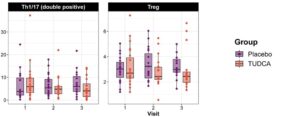October 13th
Current DMTs fail to control “smoldering” inflammation
Tarun Singhal, et al. – Harvard Medical School.
This study found that patients on high-efficacy disease-modifying therapies (DMTs; HTs) have reduced levels of microglial activation compared to patients on low-efficacy DMTs (LTs) that are still higher than those in healthy controls.
Patients fall into subtypes based on white matter glia gene expression
Will Macnair, et al. – Roche Innovation Centre.
In this study, Macnair and colleagues found that differential gene expression in white matter lesions from patients with MS is driven by donor variation, not lesion type.
Demyelination triggers neuronal death via DLK
Greg J Duncan, et al. – Oregon Health & Science University.
In this study, Duncan and colleagues demonstrated that chronic demyelination triggers apoptosis via dual leucine zipper kinase (DLK), which triggers phosphorylation of c-Jun and activates cell death pathways.
Wnt signaling from OPCs drives cytotoxic autoimmune activity
This study identified an ability for Wnt-expressing oligodendrocyte progenitor cells (OPCs) to enhance the autoimmune response in an MS model.
October 2nd
Dual role for platelets in remyelination
Amber R. Philp, et al. – Universidad Austral de Chile.
This study found that transient exposure of oligodendrocyte precursor cells (OPCs) to platelets promoted differentiation into oligodendrocytes, but prolonged exposure inhibited this process.
Lymphocytes from patients with MS lack response to IL4I1
Stephanie E. Davis, et al. – Georgetown University.
In this study, interleukin-four induced one (IL4I1) induced lymphocytes from healthy controls to favor a regulatory T-cell profile, but lymphocytes from patients with MS did not respond to IL4I1.
Metabolic regulator miR-342 affects inflammation in MS model
Rongzhen Yu, et al. – Northwestern University.
In this study, Yu and colleagues found that the microRNA miR-342 links metabolism and immune function in regulatory T cells (Tregs) in the experimental autoimmune encephalitis (EAE) mouse model of MS.
Baseline, but not new, cortical lesions predict disability progression
Erin Beck, et al. – NINDS.
This study of patients with various MS subtypes found that baseline levels of cortical lesions could predict whether subjects experienced worsening motor disability over the following 2 years.




